WHAT THEY DIDN’T TEACH YOU IN DENTAL SCHOOL
Most of us graduated from Dental school with little or no training in basic business principles. Some of us may have taken a year or two of business classes (as I did) and others may have even graduated with a business degree. Even then, there was usually little practical training on how to evaluate the typical decisions all of us must make at various points in our dental careers. Most dental schools do try to educate the senior class on these matters, however, most senior dental students are too preoccupied with getting enough credits for procedures to graduate and often skip these “optional” classes.
When I graduated from Dental school, I followed in the footsteps of a few graduates that migrated to the Phoenix area. In fact, I replaced the associate position that my colleague vacated when he left to start up his own successful dental practice from scratch. In turn, I also left after 2-3 years and did my own scratch-start practice. At the time, I never even considered purchasing an existing practice. Even if I had, I possessed no knowledge on how to properly evaluate my options. This article will provide some basic concepts to help dentists begin to think more like accountants and businessmen.
Starting a Dental Practice
The problem that most of us have is that we assume that just having a DDS after our name will ensure our success. For the most part, this is actually true! For example, I just ventured out, surveyed a new growth neighborhood and selected a highly visible, easily accessible corner to start my dental practice. Eventually everything worked out well and my practice became highly successful. However, an astute businessman would have “crunched the numbers” to ensure that he would get the best “return on his investment”. When all things are equal, without extraordinary growth, the economic gains of a practice purchase outpaces the gains of a new scratch start practice. Price, rather than generating cash flow is often the major concern of most buyers. Some buyers will comment that a practice costs too much, without even knowing what the profit of the practice is! Cash flow and return on the investment should be king!
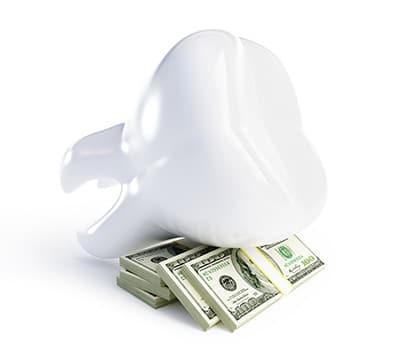
The Dollars and Cents
The following discussion will be a comparison of cash flow and profit between (a) scratch start practice (2 operatory set-up) (b) the purchase of a moderate practice (3 – 4 operatories) and (c) the purchase of a large practice (5 or more operatories). Several assumptions based on historical data are applied in the flow chart labeled Illustration 1. The industry average loan for a scratch start practice equipped with two operatories is $500,000. The purchase price of existing practices historically falls between 60 to 75 percent of gross receipts. In an effort to give our start up the best chance of success upon comparisons, we have used a multiple of 80% of the gross receipts of a typical practice purchase. Therefore, the purchase price of our $500,000 gross receipt practice and our $1,000,000 gross receipt practice will be $400,000 and $800,000 respectively. As you can see, it actually costs less to buy a medium sized practice than to start a dental practice from scratch, even if you have to upgrade some equipment.
Most dental offices usually run at approximately 60 percent overhead expenses so we have used 40 percent as our bottom line cash flow before debt service. Again, this favors the success comparison of the startup practice as profitability percentages go up with increased production. A reasonable interest rate for a loan in today’s market is about 5 percent over ten years which is reflected in the debt service column corresponding to the start-up cost or the purchase price of the practice. The net profit (before taxes) is the cash flow minus the debt service. In addition, we will also assume some fairly good start up numbers and good growth for our scratch start practice as compared to the existing practices.

Illustration 1 will then reveal the net profit before taxes for each of the seven years the practice is in debt. Also note that we did not make any additional debt service adjustments to reflect additional leasehold expenses and equipment purchases for the scratch start and moderate practices to actually produce the same numbers of the larger practice. It would cost well over $100,000 to build out and equip the scratch start practice from 2 operatories to 6 operatories. Therefore, we have given almost every advantage to the scratch start practice. In fact, when I give this presentation to large groups, many dentists in their beginning years of a scratch-start practice will despondently ask if they are supposed to be doing as well as the projections on Illustration 1.
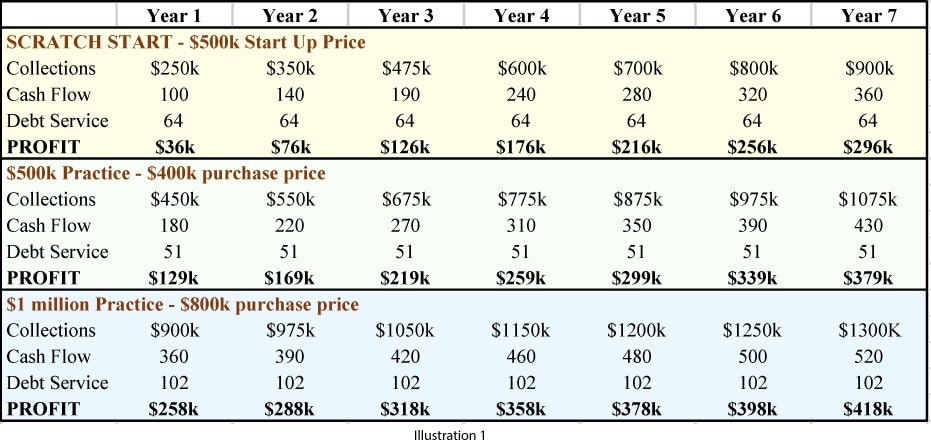
Many dental practice owners may be quick to point out the flaws in the assumptions of Illustration 1. That is not the point! Adjust the many variables to fit the complexities of your own situation. Perhaps you never want a million dollar practice or you feel that you can turn a thousand patients into two thousand relatively quickly. The point is to take this template and work up your own analysis for your particular situation.
Illustration 2 shows the Total Profits after debt service (before taxes) in this scenario at the 3, 5 and 7-year totals. As you can see, the difference in potential lost income for the scratch start practice is significant and increases year by year until theoretically you reach your full potential in your own practice. Depending on the circumstances, you can see how the decision may cost you well over $1 million dollars over several years!
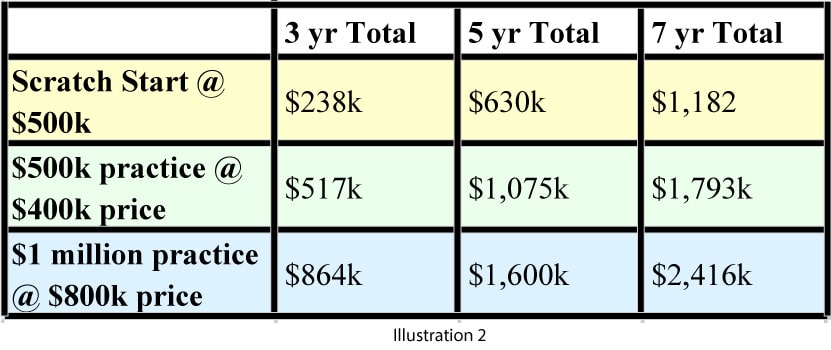
We need to touch upon another variable that further solidifies the case for buying an existing practice. The main reason for buying an existing practice is the patient base. Theoretically, the larger the patient base, the larger the gross receipts and the higher practice purchase price.
Use the Skills You Have
Therefore, if you possess the special “people skills” and practice management skills that can result in quick growth when starting a dental practice, it is more advantageous to be able to apply those skills to an existing patient base. If you do not possess those special skills that result in high growth, you definitely have a better chance for success if you buy an existing patient base.
In any event, do not just assume that you are making the best decision when the time comes to open your practice. Work out your model based on an honest evaluation of your own circumstances.
Marketing
Most practice management gurus will state that internal marketing is superior to external marketing. Many of us are familiar with Network Marketing, which is based on the concept of “friends telling friends” about a service or product. The premise is that if one friend talks to two people, and those two talk to four, and those four talk to eight, which will result in exponential growth and success. The Dentist in a scratch start practice opens his practice with relatively few patients and depending on marketing strategies, the practice will hopefully grow (SeeIllustration 3).
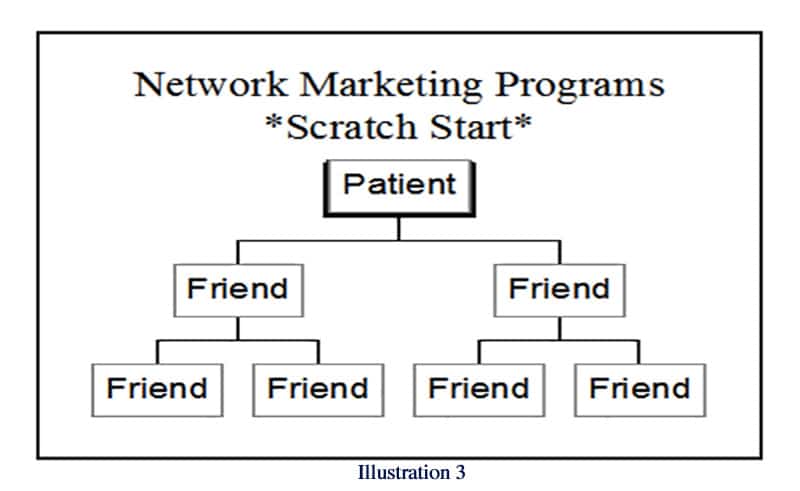
Using this same application with an existing practice, one can apply the same marketing strategies and techniques to a base of perhaps a thousand or more patients right off the start when opening for business! (See Illustration 4).
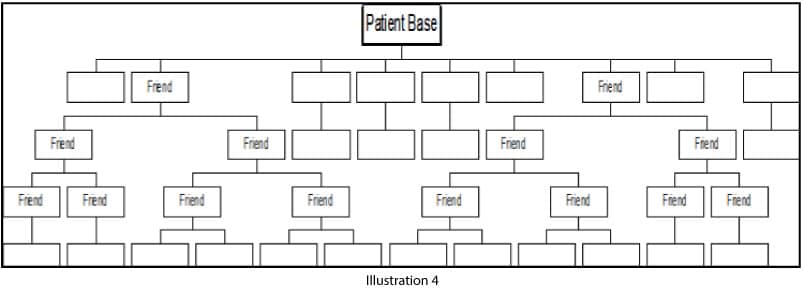
Obviously, a network marketing phenomenon in this case would produce very high growth. In reviewing the Profit Analysis, (Illustration 1) we had assumed very small growth for the large practice and that practice still showed the highest return on investment. Just imagine the differences in net profit between the scratch start practice and the practice with the existing patient base that is properly marketed and managed! In short, purchasing an existing practice historically produces quicker growth than a starting a dental practice.
This is not to say that buying an existing practice is a guarantee of success. Regarding successful practices, there are many factors that must be addressed and evaluated in a practice purchase as well as a scratch start practice. In subsequent articles, we will discuss the attributes of dental practices and the importance of proper due diligence based on the needs, expectations, opportunity and personal qualities of the dentist. We will discuss essential issues on transitioning a practice as well as the sale of your practice at retirement. Until then, do what you do best!
About the Author
Dr. Tim Giroux established his own dental practice in Scottsdale, Arizona, upon graduation from Creighton University, School of Dentistry in 1983. Relocating to Northern California upon selling his highly successful practice after 15 years, Dr. Giroux brings a unique perspective and personal experience in dental associateships, practice start-up, sales, and work-back situations to serve and assist you during your exciting transition! He especially enjoys guiding young dentists and helping them fulfill their dreams when they purchase their own dental practice.
LinkedIn | Facebook | Instagram
This entry was posted on Monday, August 12th, 2019 by ADS - Practice Transitions Made Perfect (TM) and is filed under
Practice Management,







